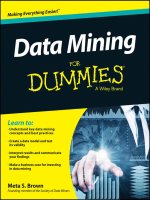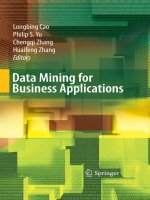IT training data mining for dummies brown 2014 09 29 2
Bạn đang xem bản rút gọn của tài liệu. Xem và tải ngay bản đầy đủ của tài liệu tại đây (9.73 MB, 411 trang )
Data Mining
Data Mining For Dummies®
Published by: John Wiley & Sons, Inc., 111 River Street, Hoboken, NJ 07030-5774, www.wiley.com
Copyright © 2014 by John Wiley & Sons, Inc., Hoboken, New Jersey
Media and software compilation copyright © 2014 by John Wiley & Sons, Inc. All rights reserved.
Published simultaneously in Canada
No part of this publication may be reproduced, stored in a retrieval system or transmitted in any form or by
any means, electronic, mechanical, photocopying, recording, scanning or otherwise, except as permitted
under Sections 107 or 108 of the 1976 United States Copyright Act, without the prior written permission of
the Publisher. Requests to the Publisher for permission should be addressed to the Permissions Department,
John Wiley & Sons, Inc., 111 River Street, Hoboken, NJ 07030, (201) 748-6011, fax (201) 748-6008, or online at
www.wiley.com/go/permissions.
Trademarks: Wiley, For Dummies, the Dummies Man logo, Dummies.com, Making Everything Easier, and
related trade dress are trademarks or registered trademarks of John Wiley & Sons, Inc. and may not be
used without written permission. Samsung and Galaxy S are registered trademarks of Samsung Electronics
Co. Ltd. All other trademarks are the property of their respective owners. John Wiley & Sons, Inc. is not
associated with any product or vendor mentioned in this book.
LIMIT OF LIABILITY/DISCLAIMER OF WARRANTY: THE PUBLISHER AND THE AUTHOR MAKE NO
REPRESENTATIONS OR WARRANTIES WITH RESPECT TO THE ACCURACY OR COMPLETENESS OF
THE CONTENTS OF THIS WORK AND SPECIFICALLY DISCLAIM ALL WARRANTIES, INCLUDING WITHOUT LIMITATION WARRANTIES OF FITNESS FOR A PARTICULAR PURPOSE. NO WARRANTY MAY BE
CREATED OR EXTENDED BY SALES OR PROMOTIONAL MATERIALS. THE ADVICE AND STRATEGIES
CONTAINED HEREIN MAY NOT BE SUITABLE FOR EVERY SITUATION. THIS WORK IS SOLD WITH THE
UNDERSTANDING THAT THE PUBLISHER IS NOT ENGAGED IN RENDERING LEGAL, ACCOUNTING, OR
OTHER PROFESSIONAL SERVICES. IF PROFESSIONAL ASSISTANCE IS REQUIRED, THE SERVICES OF
A COMPETENT PROFESSIONAL PERSON SHOULD BE SOUGHT. NEITHER THE PUBLISHER NOR THE
AUTHOR SHALL BE LIABLE FOR DAMAGES ARISING HEREFROM. THE FACT THAT AN ORGANIZATION
OR WEBSITE IS REFERRED TO IN THIS WORK AS A CITATION AND/OR A POTENTIAL SOURCE OF
FURTHER INFORMATION DOES NOT MEAN THAT THE AUTHOR OR THE PUBLISHER ENDORSES THE
INFORMATION THE ORGANIZATION OR WEBSITE MAY PROVIDE OR RECOMMENDATIONS IT MAY
MAKE. FURTHER, READERS SHOULD BE AWARE THAT INTERNET WEBSITES LISTED IN THIS WORK
MAY HAVE CHANGED OR DISAPPEARED BETWEEN WHEN THIS WORK WAS WRITTEN AND WHEN
IT IS READ.
For general information on our other products and services, please contact our Customer Care Department
within the U.S. at 877-762-2974, outside the U.S. at 317-572-3993, or fax 317-572-4002. For technical support,
please visit www.wiley.com/techsupport.
Wiley publishes in a variety of print and electronic formats and by print-on-demand. Some material
included with standard print versions of this book may not be included in e-books or in print-on-demand.
If this book refers to media such as a CD or DVD that is not included in the version you purchased, you
may download this material at . For more information about Wiley
products, visit www.wiley.com.
Library of Congress Control Number: 2014935519
ISBN 978-1-118-89317-3 (pbk); ISBN 978-1-118-89316-6 (ebk); ISBN 978-1-118-89319-7 (ebk)
Manufactured in the United States of America
10 9 8 7 6 5 4 3 2 1
Contents at a Glance
Introduction................................................................. 1
Part I: Getting Started with Data Mining........................ 5
Chapter 1: Catching the Data-Mining Train..................................................................... 7
Chapter 2: A Day in Your Life as a Data Miner.............................................................. 17
Chapter 3: Teaming Up to Reach Your Goals................................................................ 49
Part II: Exploring Data-Mining Mantras and Methods....... 61
Chapter 4: Learning the Laws of Data Mining............................................................... 63
Chapter 5: Embracing the Data-Mining Process........................................................... 73
Chapter 6: Planning for Data-Mining Success............................................................... 89
Chapter 7: Gearing Up with the Right Sof tware.............................................................97
Part III: Gathering the Raw Materials........................ 109
Chapter 8: Digging into Your Data................................................................................ 111
Chapter 9: Making New Data......................................................................................... 119
Chapter 10: Ferreting Out Public Data Sources.......................................................... 141
Chapter 11: Buying Data................................................................................................ 163
Part IV: A Data Miner’s Survival Kit........................... 171
Chapter 12: Getting Familiar with Your Data.............................................................. 173
Chapter 13: Dealing in Graphic Detail.......................................................................... 195
Chapter 14: Showing Your Data Who’s Boss............................................................... 219
Chapter 15: Your Exciting Career in Modeling............................................................ 245
Part V: More Data-Mining Methods............................ 273
Chapter 16: Data Mining Using Classic Statistical Methods...................................... 275
Chapter 17: Mining Data for Clues................................................................................ 295
Chapter 18: Expanding Your Horizons......................................................................... 307
Part VI: The Part of Tens........................................... 319
Chapter 19: Ten Great Resources for Data Miners..................................................... 321
Chapter 20: Ten Useful Kinds of Analysis That Complement Data Mining............. 325
Appendix A: Glossary................................................ 333
Appendix B: Data-Mining Sof tware Sources................ 339
Appendix C: Major Data Vendors................................ 349
Appendix D: Sources and Citations............................. 357
Index....................................................................... 361
Table of Contents
Introduction.................................................................. 1
About This Book............................................................................................... 1
Foolish Assumptions........................................................................................ 2
Icons Used in This Book.................................................................................. 2
Beyond the Book.............................................................................................. 3
Where to Go from Here.................................................................................... 3
Part I: Getting Started with Data Mining........................ 5
Chapter 1: Catching the Data-Mining Train . . . . . . . . . . . . . . . . . . . . . . . . 7
Getting Real about Data Mining...................................................................... 7
Not your professor’s statistics.............................................................. 8
The value of data mining....................................................................... 8
Working for it.......................................................................................... 9
Doing What Data Miners Do.......................................................................... 10
Focusing on the business.................................................................... 10
Understanding how data miners spend their time........................... 11
Getting to know the data-mining process.......................................... 11
Making models...................................................................................... 12
Understanding mathematical models................................................ 12
Putting information into action........................................................... 13
Discovering Tools and Methods................................................................... 13
Visual programming............................................................................. 14
Working quick and dirty...................................................................... 15
Testing, testing, and testing some more............................................ 16
Chapter 2: A Day in Your Life as a Data Miner. . . . . . . . . . . . . . . . . . . . . 17
Starting Your Day Off Right........................................................................... 17
Meeting the team.................................................................................. 18
Exploring with aim................................................................................ 18
Structuring time with the right process............................................ 20
Understanding Your Business Goals............................................................ 20
Understanding Your Data.............................................................................. 22
Describing data..................................................................................... 22
Exploring data....................................................................................... 23
Cleaning data......................................................................................... 27
Preparing Your Data....................................................................................... 28
Taking first steps with the property data.......................................... 28
Preparing the ownership change indicator....................................... 32
Merging the datasets............................................................................ 32
Deriving new variables......................................................................... 34
viii
Data Mining For Dummies
Modeling Your Data........................................................................................ 40
Using balanced data............................................................................. 40
Splitting data......................................................................................... 41
Building a model................................................................................... 43
Evaluating Your Results................................................................................. 44
Examining the decision tree................................................................ 44
Using a diagnostic chart...................................................................... 46
Assessing the status of the model...................................................... 47
Putting Your Results into Action.................................................................. 48
Chapter 3: Teaming Up to Reach Your Goals. . . . . . . . . . . . . . . . . . . . . . 49
Nothing Could Be Finer Than to Be a Data Miner...................................... 49
You can be a data miner...................................................................... 50
Using the knowledge you have........................................................... 51
Data Miners Play Nicely with Others........................................................... 51
Cooperation is a necessity.................................................................. 51
Oh, the people you’ll meet!.................................................................. 53
Working with Executives............................................................................... 56
Greetings and elicitations.................................................................... 57
Lining up your priorities...................................................................... 58
Talking data mining with executives.................................................. 58
Part II: Exploring Data-Mining Mantras and Methods..... 61
Chapter 4: Learning the Laws of Data Mining . . . . . . . . . . . . . . . . . . . . . 63
1st Law: Business Goals................................................................................. 63
2nd Law: Business Knowledge...................................................................... 64
3rd Law: Data Preparation............................................................................. 65
4th Law: Right Model..................................................................................... 66
5th Law: Pattern.............................................................................................. 67
6th Law: Amplification................................................................................... 68
7th Law: Prediction........................................................................................ 69
8th Law: Value................................................................................................. 70
9th Law: Change.............................................................................................. 70
Chapter 5: Embracing the Data-Mining Process. . . . . . . . . . . . . . . . . . . 73
Whose Standard Is It, Anyway?..................................................................... 73
Approaching the process in phases................................................... 74
Cycling through phases and projects................................................ 74
Documenting your work...................................................................... 75
Business Understanding................................................................................ 76
Data Understanding........................................................................................ 79
Data Preparation............................................................................................. 82
Modeling.......................................................................................................... 84
Evaluation........................................................................................................ 86
Deployment..................................................................................................... 87
Table of Contents
Chapter 6: Planning for Data-Mining Success . . . . . . . . . . . . . . . . . . . . 89
Setting the Course with Formal Business Cases......................................... 89
Satisfying the boss................................................................................ 90
Minimizing your own risk.................................................................... 91
Building Business Cases................................................................................ 91
Elements of the business case............................................................ 92
Putting it in writing............................................................................... 94
The basics on benefits......................................................................... 94
Avoiding the Failure Option.......................................................................... 95
Chapter 7: Gearing Up with the Right Sof tware. . . . . . . . . . . . . . . . . . . . 97
Putting Data-Mining Tools in Perspective................................................... 97
Avoiding software risks........................................................................ 98
Focusing on business goals, not tools............................................... 99
Determining what you need.............................................................. 100
Comparing tools.................................................................................. 101
Shopping for software........................................................................ 103
Evaluating Software...................................................................................... 104
Don’t fall in love (with your software)............................................. 105
Engaging with sales representatives................................................ 106
The sales professional’s mantra — BANT....................................... 107
Part III: Gathering the Raw Materials......................... 109
Chapter 8: Digging into Your Data . . . . . . . . . . . . . . . . . . . . . . . . . . . . . . 111
Focusing on a Problem................................................................................ 111
Managing Scope............................................................................................ 113
Using Your Organization’s Own Data......................................................... 115
Appreciating your own data.............................................................. 116
Handling data with respect............................................................... 117
Chapter 9: Making New Data . . . . . . . . . . . . . . . . . . . . . . . . . . . . . . . . . . 119
Fathoming Loyalty Programs...................................................................... 119
Grasping the loyalty concept............................................................ 120
Your data bonanza............................................................................. 121
Putting loyalty data to work.............................................................. 122
Testing, Testing . . ....................................................................................... 124
Experimenting in direct marketing................................................... 125
Spying test opportunities.................................................................. 126
Testing online...................................................................................... 126
Microtargeting to Win Elections................................................................. 127
Treating voters as individuals........................................................... 127
Looking at an example....................................................................... 128
Enhancing voter data......................................................................... 128
ix
x
Data Mining For Dummies
Gaining an information advantage.................................................... 129
Developing your own test data......................................................... 129
Taking discoveries on the campaign trail........................................ 130
Surveying the Public Landscape................................................................. 131
Eliciting information with surveys.................................................... 131
Using surveys...................................................................................... 132
Developing questions......................................................................... 133
Conducting surveys............................................................................ 134
Recognizing limitations...................................................................... 134
Bringing in help................................................................................... 135
Getting into the Field.................................................................................... 136
Going where no data miner has gone before.................................. 136
Doing more than asking..................................................................... 137
One Challenge, Many Approaches............................................................. 138
Chapter 10: Ferreting Out Public Data Sources. . . . . . . . . . . . . . . . . . . 141
Looking Over the Lay of the Land.............................................................. 141
Exploring Public Data Sources.................................................................... 142
United States federal government.................................................... 144
Governments around the world........................................................ 157
United States state and local governments..................................... 158
Chapter 11: Buying Data. . . . . . . . . . . . . . . . . . . . . . . . . . . . . . . . . . . . . . . 163
Peeking at Consumer Data.......................................................................... 164
Beyond Consumer Data............................................................................... 167
Desperately Seeking Sources...................................................................... 168
Assessing Quality and Suitability............................................................... 169
Part IV: A Data Miner’s Survival Kit........................... 171
Chapter 12: Get ting Familiar with Your Data. . . . . . . . . . . . . . . . . . . . . 173
Organizing Data for Mining.......................................................................... 173
Getting Data from There to Here................................................................ 175
Text files............................................................................................... 175
Databases............................................................................................. 189
Spreadsheets, XML, and specialty data formats............................. 190
Surveying Your Data.................................................................................... 191
Chapter 13: Dealing in Graphic Detail. . . . . . . . . . . . . . . . . . . . . . . . . . . 195
Starting Simple.............................................................................................. 195
Eyeballing variables with bar charts and histograms.................... 196
Relating one variable to another with scatterplots........................ 199
Table of Contents
Building on Basics........................................................................................ 202
Making scatterplots say more........................................................... 202
Interacting with scatterplots............................................................. 204
Working Fast with Graphs Galore............................................................... 211
Extending Your Graphics Range................................................................. 213
Chapter 14: Showing Your Data Who’s Boss. . . . . . . . . . . . . . . . . . . . . 219
Rearranging Data.......................................................................................... 220
Controlling variable order................................................................. 220
Formatting data properly.................................................................. 221
Labeling data....................................................................................... 223
Controlling case order....................................................................... 226
Getting rows and columns right....................................................... 228
Putting data where you need it......................................................... 229
Sifting Out the Data You Need.................................................................... 233
Narrowing the fields........................................................................... 233
Selecting relevant cases..................................................................... 235
Sampling............................................................................................... 236
Getting the Data Together........................................................................... 238
Merging................................................................................................ 238
Appending............................................................................................ 239
Making New Data from Old Data................................................................. 239
Deriving new variables....................................................................... 240
Aggregation.......................................................................................... 240
Saving Time................................................................................................... 243
Chapter 15: Your Exciting Career in Modeling . . . . . . . . . . . . . . . . . . . 245
Grasping Modeling Concepts...................................................................... 245
Cultivating Decision Trees.......................................................................... 247
Examining a decision tree.................................................................. 247
Using decision trees to aid communication.................................... 248
Constructing a decision tree............................................................. 249
Getting acquainted with common decision tree types.................. 260
Adapting to your tools....................................................................... 261
Neural Networks for Prediction.................................................................. 263
Looking inside a neural network....................................................... 263
Issues surrounding neural network models.................................... 266
Clustering...................................................................................................... 267
Supervised and unsupervised learning............................................ 268
Clustering to clarify............................................................................ 268
xi
xii
Data Mining For Dummies
Part V: More Data-Mining Methods............................. 273
Chapter 16: Data Mining Using Classic Statistical Methods . . . . . . . 275
Understanding Correlation.......................................................................... 275
Picturing correlations........................................................................ 276
Measuring the strength of a correlation.......................................... 278
Drawing lines in the data................................................................... 279
Giving correlations a try.................................................................... 280
Understanding Linear Regression.............................................................. 283
Working with straight lines............................................................... 283
Finding the best line........................................................................... 287
Using linear regression coefficients................................................. 288
Interpreting model statistics............................................................. 290
Applying common sense.................................................................... 290
Understanding Logistic Regression........................................................... 292
Looking into logistic regression........................................................ 292
Appreciating the appeal of logistic regression............................... 293
Looking over a logistic regression example.................................... 293
Chapter 17: Mining Data for Clues. . . . . . . . . . . . . . . . . . . . . . . . . . . . . . 295
Tracking Combinations................................................................................ 296
Finding Associations in Data....................................................................... 296
Structuring association rules............................................................ 297
Getting ready....................................................................................... 297
Shopping for associations................................................................. 300
Refining results................................................................................... 303
Understanding the metrics................................................................ 306
Chapter 18: Expanding Your Horizons. . . . . . . . . . . . . . . . . . . . . . . . . . . 307
Squeezing More Out of What You Have..................................................... 307
Mastering your data-mining application.......................................... 307
Fine-tuning your settings................................................................... 308
Analyzing your analysis..................................................................... 309
Using meta-models (ensemble models)........................................... 309
Widening Your Range................................................................................... 310
Tackling text........................................................................................ 310
Detecting sequences.......................................................................... 312
Working with time series................................................................... 313
Taking on Big Data........................................................................................ 314
Coming to terms with Big Data......................................................... 315
Conducting predictive analytics with Big Data............................... 315
Blending Methods for Best Results............................................................ 317
Table of Contents
Part VI: The Part of Tens............................................ 319
Chapter 19: Ten Great Resources for Data Miners . . . . . . . . . . . . . . . . 321
Society of Data Miners................................................................................. 321
KDnuggets...................................................................................................... 321
All Analytics.................................................................................................. 322
The New York Times.................................................................................... 322
Forbes............................................................................................................ 323
SmartData Collective.................................................................................... 323
CRISP-DM Process Model............................................................................ 323
Nate Silver..................................................................................................... 324
Meta’s Analytics Articles page.................................................................... 324
First Internet Gallery of Statistics Jokes.................................................... 324
Chapter 20: Ten Useful Kinds of Analysis That Complement
Data Mining . . . . . . . . . . . . . . . . . . . . . . . . . . . . . . . . . . . . . . . . . . . . . . . . . 325
Business Analysis......................................................................................... 325
Conjoint Analysis.......................................................................................... 326
Design of Experiments................................................................................. 327
Marketing Mix Modeling.............................................................................. 327
Operations Research.................................................................................... 328
Reliability Analysis....................................................................................... 329
Statistical Process Control.......................................................................... 330
Social Network Analysis.............................................................................. 330
Structural Equation Modeling..................................................................... 331
Web Analytics............................................................................................... 331
Appendix A: Glossary................................................. 333
Appendix B: Data-Mining Sof tware Sources................. 339
Appendix C: Major Data Vendors................................. 349
Appendix D: Sources and Citations.............................. 357
Index........................................................................ 361
xiii
xiv
Data Mining For Dummies
Introduction
D
ata mining is the way that businesspeople can explore data independently, make informative discoveries, and put that information to work
in everyday business. You don’t need to be an expert in statistics, a scientist,
or a computer programmer to be a data miner. You don’t need mountains of
data or special computers to do data mining.
This book is written for people who know much more about their own business than about math. It’s for people who have ordinary computers, the
same ones they use every day for word processing and spreadsheet juggling.
The most important thing is that this book is for people who have real business problems to solve, and are motivated to use data to help solve those
problems.
About This Book
This is a guidebook for people who have heard a little about data mining and
want to give it a try. It contains all the information you need to get started as
a hands-on data miner. If you don’t want to become a data miner yourself, but
do want to know what data mining is all about, this book will work for you,
too. And although the book was aimed for beginners, data miners with some
experience may flip through and find a few fresh pointers, too.
If you try out all (okay, most) of the methods in this book, use them to
investigate your own data, and solve a business problem of your own, you’ll
become a data miner.
Read on, and you will discover the following:
✓How data miners work, and the principles and processes of data mining
✓Why teaming with other roles is essential to successful data mining
✓Why your data is valuable
✓How and where to get additional data
✓Why choosing tools shouldn’t be your first concern
2
Data Mining For Dummies
✓What data-mining techniques are basics for data mining
✓How you can extend your bag of tricks with new techniques
✓Where to go to keep on learning
Foolish Assumptions
If you think it’s foolish to make assumptions, try going a week without making
one. Assumptions give us a starting point for everything we do. The trick is
not to make too many assumptions or unreasonable ones.
This book assumes a few things. It assumes that you are comfortable with
everyday business computing like using office applications. It assumes that
you are fairly comfortable with numbers and interpreting tables and graphs.
And it assumes that you have a real-life job to do and you want to do it better
with the help of data mining. It would not hurt if you’ve had some exposure
to statistical analysis, but that won’t be assumed.
One more thing: It assumes that you’re new to data mining. If you’re a little
more experienced, you may want to skip over sections on familiar topics and
get right into the stuff that’s new to you.
Icons Used in This Book
As you read this book, you’ll see icons in the margins that indicate special
kinds of material. This section briefly describes each icon in this book.
Tips are the handy hints that help you do things a little more easily, quickly, or
thoroughly than you might do otherwise. These are the little tricks that experienced data miners wish they had known from the start.
Warnings are there to help you avoid pitfalls. Sometimes, they are also code
for “Don’t do the same stupid thing that I did that one time. Or maybe twice.
Okay, 12 times.”
You won’t see many of these in this book. They are geeky bits put in to satisfy
the nagging curiosity of people who are a little more familiar with statistics
than the typical novice data miner. It’s usually okay to skip these paragraphs.
Introduction
When it says “Remember,” read that part a couple of times, because it’s so
easy to forget stuff, and you’ll be better off if you remember this material.
Beyond the Book
You’ll find more about data mining at www.dummies.com. Go online to find
these resources:
✓Online articles covering additional topics can be found at
www.dummies.com/extras/datamining
Here you’ll find out how to start a search for data on the federal government’s data portal, what common data-mining mistakes you can avoid,
and more.
✓The Cheat Sheet for this book can be found at
www.dummies.com/cheatsheet/datamining
This is a handy quick reminder sheet of information drawn from this
book.
✓Updates to this book may be found at
www.dummies.com/extras/datamining
Where to Go from Here
Your journey to become a data miner begins now.
This book was written with beginners in mind, so if you are new to data
mining, begin with Chapter 1 to get an overview, or Chapter 2, which shows
the work you might do in a typical day as a data miner working with data to
address a real application, and see which topics interest you the most. Then
go directly to the chapters that cover those topics, or, alternatively, work
your way through the rest of the chapters in order.
Part I, Getting Started with Data Mining, lets you know what data mining
really is, and what it’s like to be a data miner.
Part II, Exploring Data Mining Mantras and Methods, takes you deeper to
understand how data miners work. You’ll find out about data-mining principles, processes, planning, and tools.
3
4
Data Mining For Dummies
And in Part III, Gathering the Raw Materials, you’ll get into the heart of data
mining: data itself. You’ll discover what’s great about your own data, how to
obtain new data to fill gaps in what you have, and how and where to look for
data from public and commercial sources.
If you have no patience for any of that, and want to try some new computing
tricks right away, skip to Part IV, A Data Miner’s Survival Kit, where you’ll find
out about getting data into your data-mining tool, making it do your bidding,
exploring it with graphs, and getting started in predictive modeling.
For those who have plowed through the survival kit and still yearn for more,
continue to Part V, More Data-Mining Methods. The fancy stuff is in there. If
you already have data-mining experience and you’re looking for new tricks,
you can skip to this part.
Finally, you reach Part VI, The Part of Tens. This is the book’s goody bag,
where you’ll find leads on more resources for data miners, like what to read
and where to network with other data miners, and discover a bunch of complementary data analysis techniques that aren’t data mining, but may come
in very handy one day.
Part I
Getting Started with
Data Mining
Visit www.dummies.com for great For Dummies content online.
In this part . . .
✓ Understanding how data miners work
✓ Looking over a data miner’s shoulder
✓ Working constructively with your counterparts in complementary professions
✓ Keeping it legal with good data privacy protection
✓ Communicating with executives
Chapter 1
Catching the Data-Mining Train
Y
ou’ve picked an exciting moment to become a data miner.
By some estimates, more than 15 exabytes of new data are now produced
each year. How much is that? It’s really, ridiculously big — that’s how
much! Why is this important? Most organizations have access to only a
teeny, tiny fraction of that data, and they aren’t getting much value from
what they have.
Data can be a valuable resource for business, government, and nonprofit
organizations, but quantity isn’t what’s important about it. A greater quantity
of data does not guarantee better understanding or competitive advantage.
In fact, used well, a little bit of relevant data provides more value than any
poorly used gargantuan database. As a data miner, it’s your mission to make
the most of the data you have.
This chapter goes over the basics of data mining. Here I explain what data
miners do and the tools and methods they use to do it.
Getting Real about Data Mining
Maybe you’ve heard news reports or ads hinting that all you need to make
valuable information pop out like magic is a big database and the latest software. That’s nonsense. Data miners have to work and think to make valuable
discoveries.
Maybe you’ve heard that to get results out of your database, you must first
hire one of a special breed of people who have nearly super-human knowledge of data, people known to be very expensive, nearly impossible to find,
and absolutely necessary to your success. That’s nonsense, too. Data miners
are ordinary, motivated people who complement their business knowledge
with the fundamentals of data analysis.
Data mining is not magic and not art. It’s a craft, one that mere mortals learn
every day. You can find out about it, too.
8
Part I: Getting Started with Data Mining
Not your professor’s statistics
Perhaps you took a class in statistics a long time ago and felt overwhelmed
by the professor’s insistence on rigorous methods. Relax. You’re out to find
information to support everyday business decisions, and many everyday
business problems can be solved using less formal analysis methods than the
ones you learned at school. Give yourself some slack.
How do you give yourself slack? By data mining, that’s how.
Data mining is the way that ordinary businesspeople use a range of data analysis techniques to uncover useful information from data and put that information
into practical use. Data miners use tools designed to help the work go quickly.
They don’t fuss over theory and assumptions. They validate their discoveries
by testing. And they understand that things change, so when the discovery that
worked like a charm yesterday doesn’t hold up today, they adapt.
The value of data mining
Business managers already have desks piled high with reports. Some have
access to computer dashboards that let them see their data in myriad
segments and summaries. Can data mining really add value? It can.
Typical business reports provide summaries of what has happened in the
past. They don’t offer much, if anything, to help you understand why those
things happened, or how you might influence what will happen next.
Data mining is different.
Here are examples of information that has been uncovered through data mining:
✓A retailer discovered that loyalty program sign-ups could be used to
identify which customers were most likely to spend a lot and which
would spend a little over time, based on just the information gathered
on the customer’s first visit. This information enabled the retailer to
focus marketing investment on the high spenders to maximize revenue
and reduce marketing costs.
✓A manufacturer discovered a sequence of events that preceded
accidental releases of toxic materials. This information enabled the
manufacturer to keep the facility operating while preventing dangerous accidents (protecting people and the environment) and avoiding
fines and other costs.
Chapter 1: Catching the Data-Mining Train
✓An insurance company discovered that one of its offices was able
to process certain common claim types more quickly than others of
comparable size. This information enabled the insurance company to
identify the right place to look for best practices that could be adopted
across the organization to reduce costs and improve customer service.
Data mining helps you understand how the elements of your business relate
to one another. It provides clues about actions that you can take to make
your business run more smoothly and generate more revenue. It can help
you identify where you can cut costs without damaging the organization, and
where spending brings the best returns.
Data mining provides value by helping you to better understand how your
business works.
Working for it
A lot of people have unrealistic expectations about data mining. That’s understandable, because most people get their information about data mining from
people who have never done it.
Trust data or trust your gut?
Can intuition tell you what motivates people
to buy, donate, or take action? Many people
believe that no data analysis can outdo their
own gut feel for guiding decisions.
I challenged business managers to put their
intuition to the test. They came from a variety
of industries, businesses small and large, and
included both young and experienced managers. Each viewed ten pairs of ads like these:
✓ Two nearly identical ads, differing only in
that one showed a female face and the
other a male. Which generated more leads?
✓ An ad with many images was contrasted
with one that had just a few. Which one
resulted in more purchases?
✓ Two ads had the same copy (text) but
different layouts. Which would draw more
donations for a charity?
Small variations in images, layout, or copy can
make dramatic differences in an ad’s effectiveness. Tests of the samples in this guessing
game demonstrated that the right choice could
lift conversions (actions on the part of the customer, such as buying, donating, or requesting
information) by 10 percent, 30 percent, and
sometimes more. In one case, the superior ad
resulted in 100 percent more conversion than
the alternative.
Could anyone tell, just by looking, which alternatives would perform best? No. None of the
managers were effective at picking the best
ads. Flipping a coin worked just as well.
If you want to make good business decisions,
you need data. Use your brain, not your gut!
9









